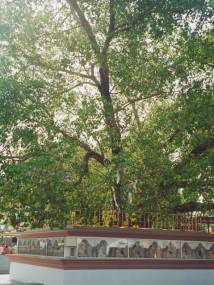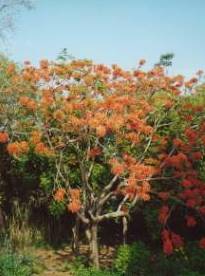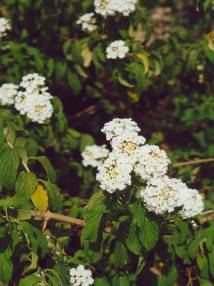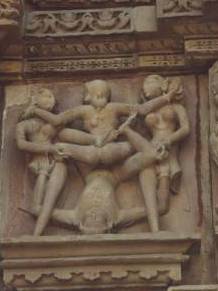Recent photos from the North India Plains
 The
celebrated deer park at Sarnath, 14km from Varanasi, where Buddha preached his
first sermon beneath
this tree some 2500 years ago after enlightenment, to his five disciples, after
searching for them in the forest for 2 months.
The
celebrated deer park at Sarnath, 14km from Varanasi, where Buddha preached his
first sermon beneath
this tree some 2500 years ago after enlightenment, to his five disciples, after
searching for them in the forest for 2 months.
According
to legend, a sapling from the original bhodi tree (Ficus religiosa) under which Buddah sat in the forest and gained
enlightenment, was transplanted to Sri Lanka where it still survives. A F.
religiosa tree in Sri Lanka was confirmed as early as 1948 as being at least
2,200 years old (ref: Champion H.G. and Griffith A.L. Manual of General Silviculture for India OUP 1948 p99).
![]()
![]()

Butea monosperma,
Flame of the Forest at Khajuraho. The twisted
trunk and branches typify this tree, which bears bright orange flowers in
clusters.
According to “The Useful Plants of India” published by the
CSIR, seeds of this tree macerated with lemon juice are used successfully for
the form of herpes known as the Dhobie itch. The tree is important for the
cultivation of the lac insect from which source it is said to produce a more lac
than on any other tree, although the quality is not superior. The astringent
ruby red clear “Bengal kino” gum is produced from the bark by incision, and
is used to treat diahorrea.
![]()
![]()
 Lantana.
camara
L. var. aculeata Moldenke is a common
bushy shrub in India, used extensively as a hedging plant, but whose who’s
prolific growth is fast becoming creating a serious nuisance. Lantana
is a large genus of bushy shrubs, prized for their ornamental value in gardens,
and widely used by florists. Lantana camara
L. itself, grows profusely on the Madagascan East coast and in Commores having
been introduced from its native South America, but L.
camara proper is not believed to grow in India, only a few varieties.
Essential oil is obtainable from the leaves and fruits of this plant, but
is not much used in perfumery.
There are doubts about safety of this plant as it is said to be fatal to
cattle. There is some limited use of the leaf oil in Indian ethnic medicine, to
treat itchy skin conditions and as an antiseptic for minor skin traumas.
Lantana.
camara
L. var. aculeata Moldenke is a common
bushy shrub in India, used extensively as a hedging plant, but whose who’s
prolific growth is fast becoming creating a serious nuisance. Lantana
is a large genus of bushy shrubs, prized for their ornamental value in gardens,
and widely used by florists. Lantana camara
L. itself, grows profusely on the Madagascan East coast and in Commores having
been introduced from its native South America, but L.
camara proper is not believed to grow in India, only a few varieties.
Essential oil is obtainable from the leaves and fruits of this plant, but
is not much used in perfumery.
There are doubts about safety of this plant as it is said to be fatal to
cattle. There is some limited use of the leaf oil in Indian ethnic medicine, to
treat itchy skin conditions and as an antiseptic for minor skin traumas.
![]()
![]()

At Khajuraho some eighty-five temples were said to be found, although only some twenty remain today, mainly Hindu, and one or two Jain. On some of the temple side walls are erotic carvings, which have been variously interpreted as pornographic, or intended for sex-education. In fact many are persuaded that the carvings actually represent the divine marriage of Shiva and Parvati, with other representations depicting passers-by stopping their everyday tasks and diversions, to catch a glimpse of the wedding-party.
![]()
![]()
Recent photos from the North India Hills
Copyright © 2001 by Tony Burfield. All Rights Reserved.